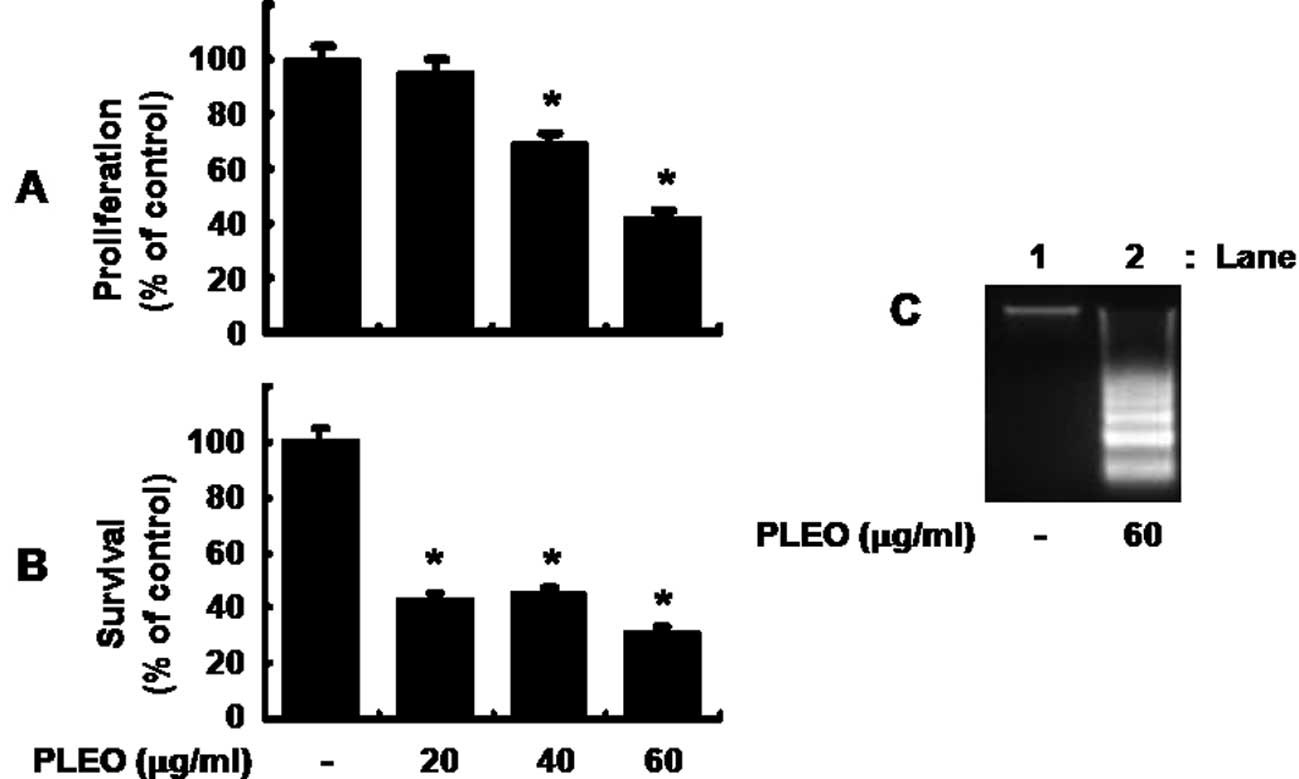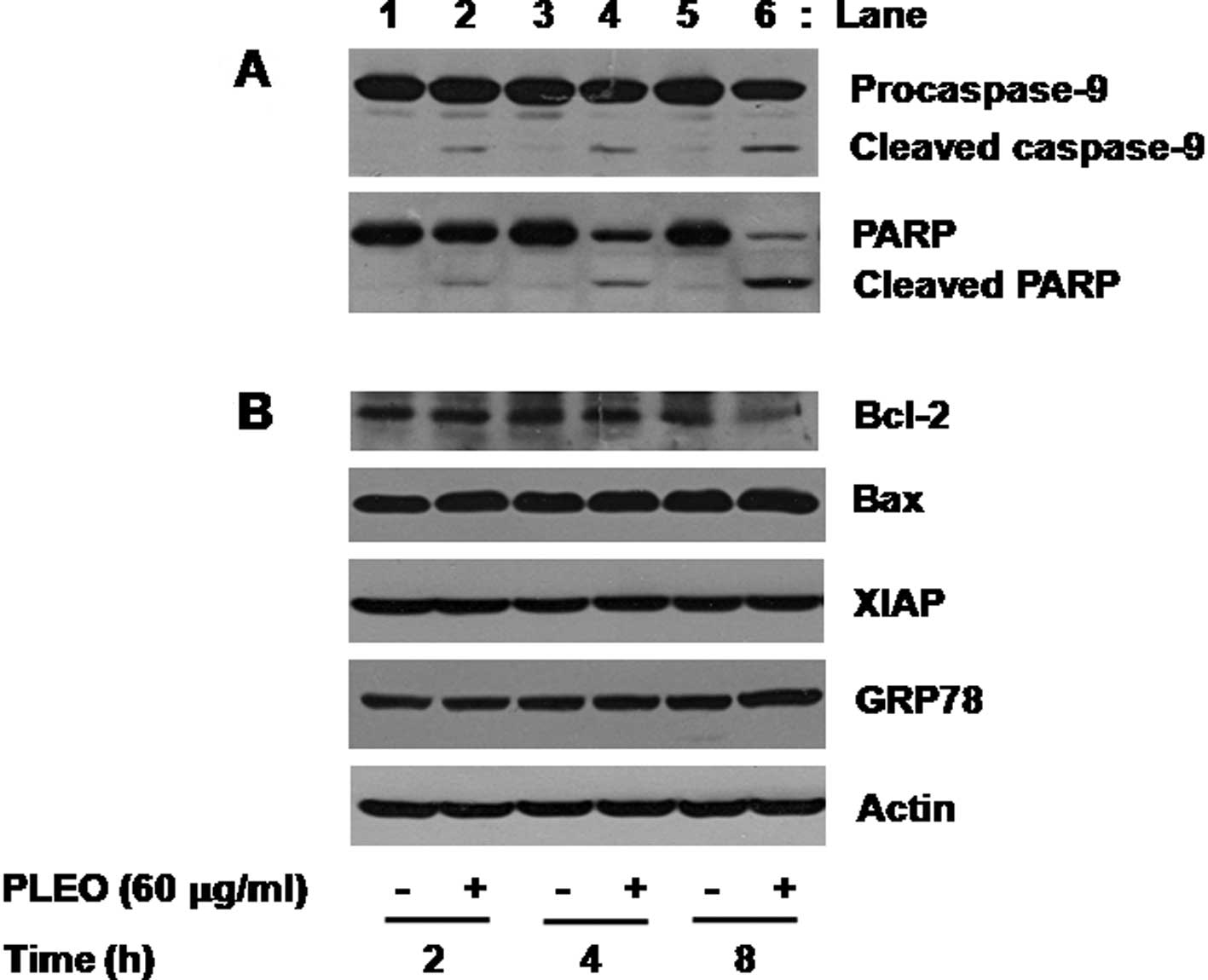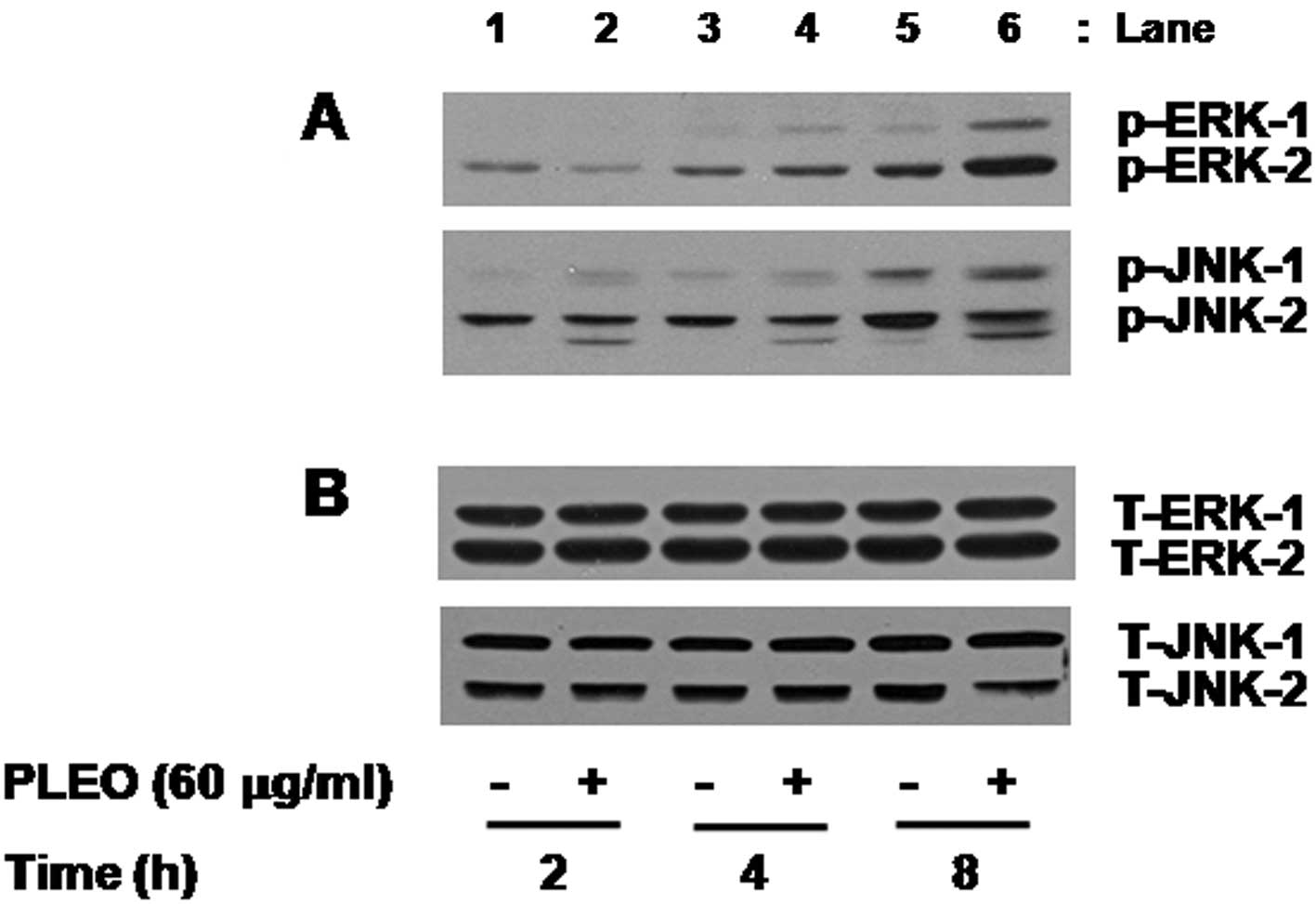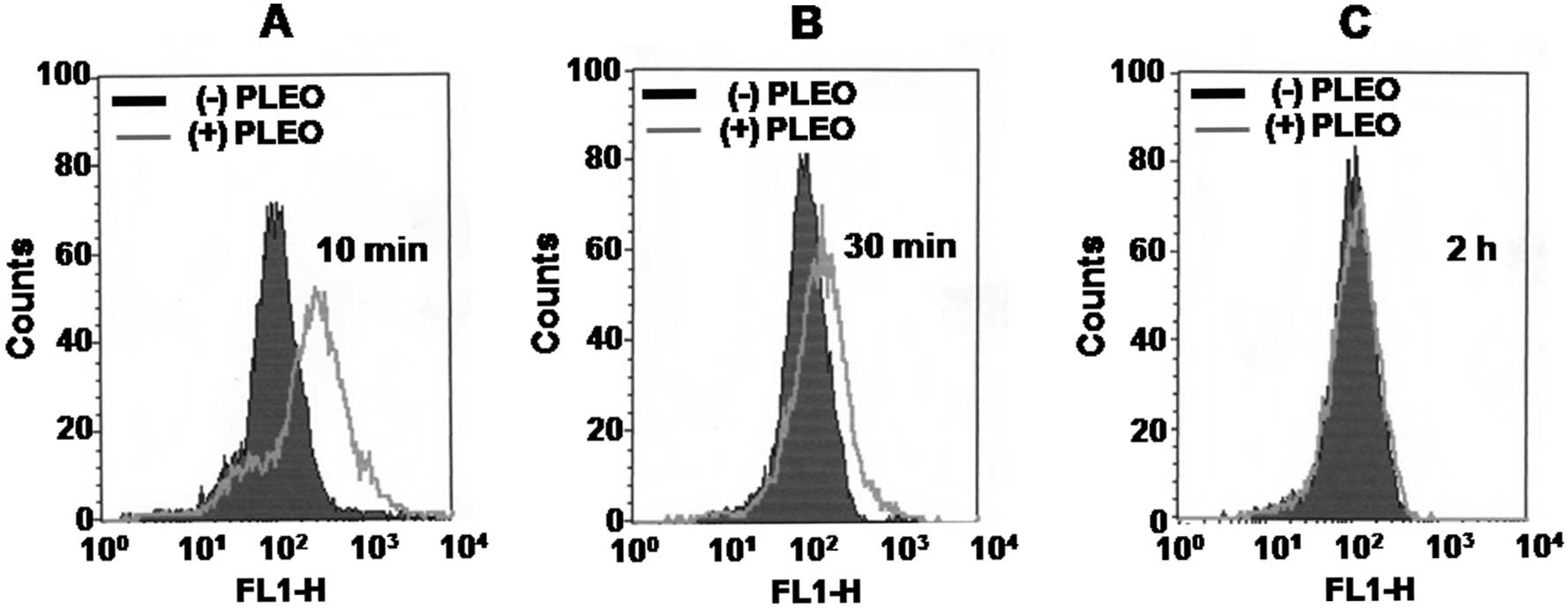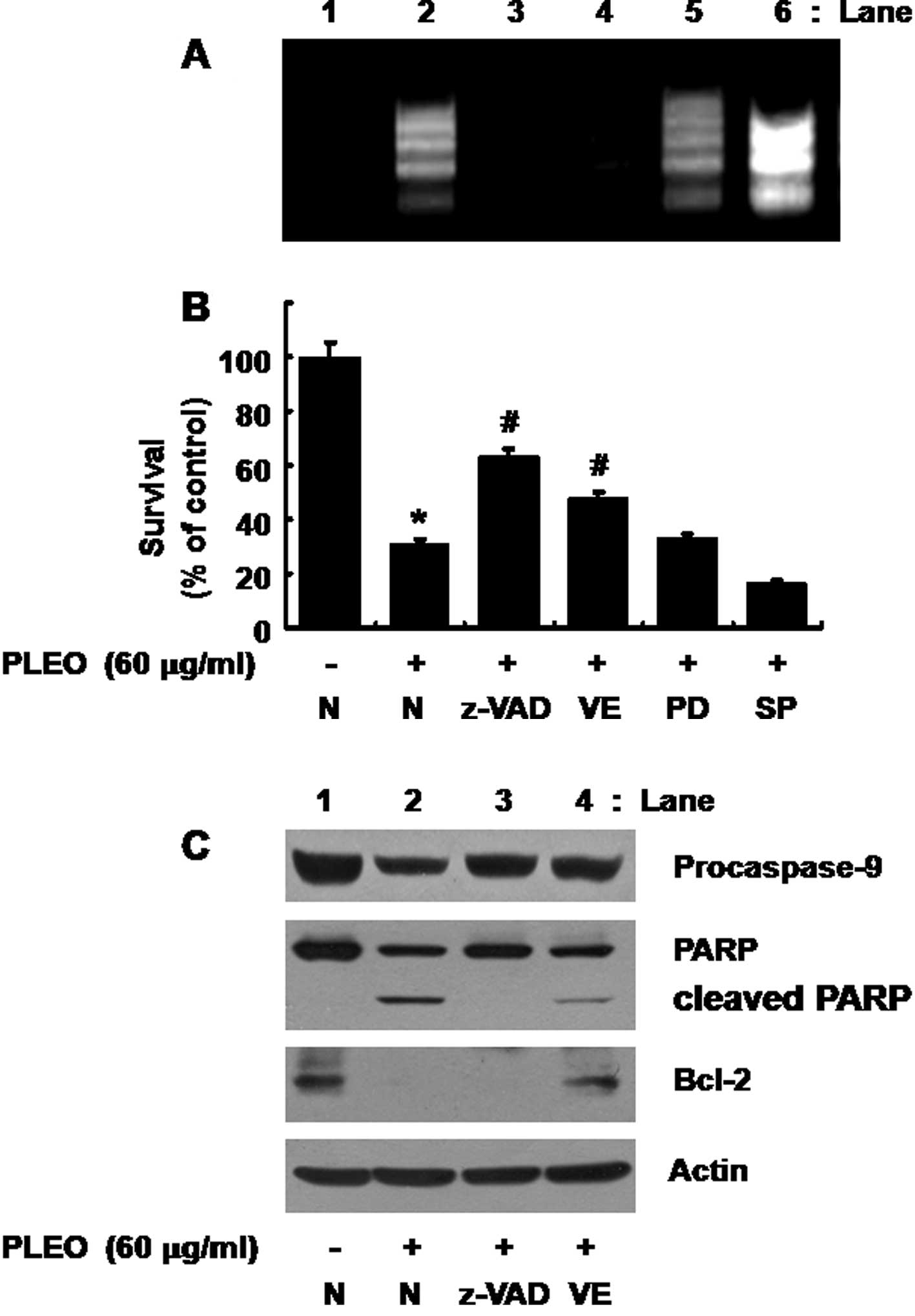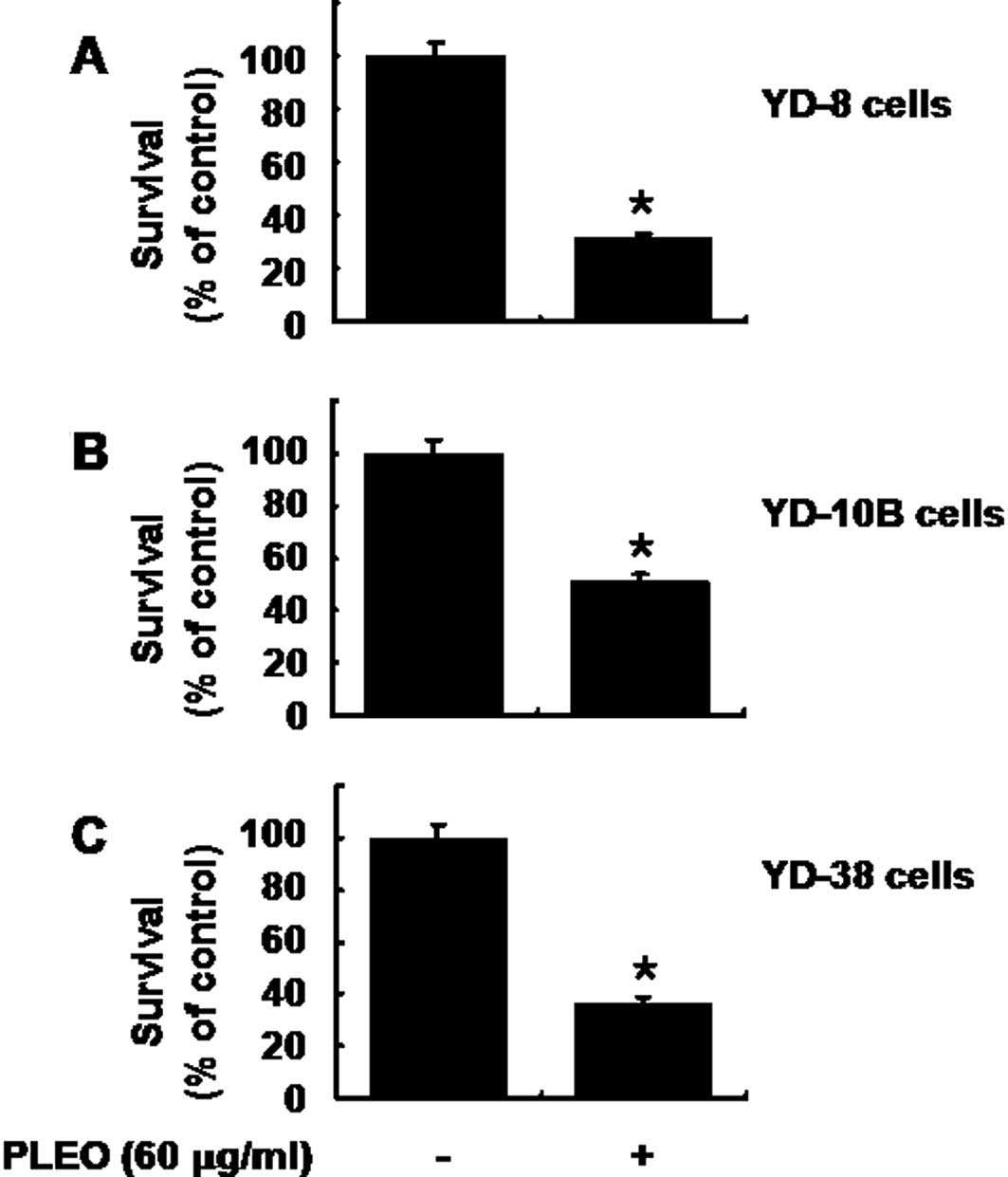|
1
|
Zain RB: Cultural and dietary risk factors
of oral cancer and precancer - a brief overview. Oral Oncol.
37:205–210. 2001. View Article : Google Scholar : PubMed/NCBI
|
|
2
|
Claus F, Duthoy W, Boterberg T, et al:
Intensity modulated radiation therapy for oropharyngeal and oral
cavity tumors: clinical use and experience. Oral Oncol. 38:597–604.
2002. View Article : Google Scholar : PubMed/NCBI
|
|
3
|
Nakazawa M, Ohnishi T, Ohmae M, et al:
Phase II study of a novel oral formation of 5-fluorouracil in
combination with low-dose cisplatin as preoperative chemotherapy of
oral squamous cell carcinoma. Int J Clin Pharmacol Res. 25:115–122.
2005.PubMed/NCBI
|
|
4
|
Wyllie AH, Kerr JF and Currie AR: Cell
death: the significance of apoptosis. Int Rev Cytol. 68:251–306.
1980. View Article : Google Scholar
|
|
5
|
Cohen GM: Caspases: the executioners of
apoptosis. Biochem J. 326:1–16. 1997.
|
|
6
|
Adams JM and Cory S: The Bcl-2 protein
family: arbiters of cell survival. Science. 281:1322–1326. 1998.
View Article : Google Scholar : PubMed/NCBI
|
|
7
|
Deveraux QL and Reed JC: IAP family
proteins - suppressors of apoptosis. Genes Dev. 13:239–252. 1999.
View Article : Google Scholar : PubMed/NCBI
|
|
8
|
Van Themsche C, Chaudhry P, Leblanc V, et
al: XIAP gene expression and function is regulated autocrine and
paracrine TGF-beta signaling. Mol Cancer. 9:2162010.PubMed/NCBI
|
|
9
|
Fleury C, Mignotte B and Vayssiere JL:
Mitochondrial reactive oxygen species in cell death signaling.
Biochimie. 84:131–141. 2002. View Article : Google Scholar : PubMed/NCBI
|
|
10
|
Simon HU, Haj-Yehia A and Levi-Schaffer F:
Role of reactive oxygen species (ROS) in apoptosis induction.
Apoptosis. 5:415–418. 2000. View Article : Google Scholar : PubMed/NCBI
|
|
11
|
Groenendyk J and Michalak M: Endoplasmic
reticulum quality control and apoptosis. Acta Biochim Pol.
52:381–395. 2005.PubMed/NCBI
|
|
12
|
Huang X, Zhang Z, Jia L, et al:
Endoplasmic reticulum stress contributes to vitamin E
succinate-induced apoptosis in human gastric cancer SGC-7901 cells.
Cancer Lett. 296:123–131. 2010. View Article : Google Scholar : PubMed/NCBI
|
|
13
|
Feuerstein GZ and Young PR: Apoptosis in
cardiac diseases: stress- and mitogen-activated signaling pathways.
Cardiovasc Res. 45:560–569. 2000. View Article : Google Scholar : PubMed/NCBI
|
|
14
|
Lucas M and Sánchez-Margalet V: Protein
kinase C involvement in apoptosis. Gen Pharmacol. 26:881–887. 1995.
View Article : Google Scholar
|
|
15
|
Bakkali F, Averbeck S, Averbeck D, et al:
Biological effects of essential oils - a review. Food Chem Toxicol.
46:446–475. 2008. View Article : Google Scholar : PubMed/NCBI
|
|
16
|
Hajhashemi V, Ghannadi A and Sharif B:
Anti-inflammatory and analgesic properties of the leaf extracts and
essential oil of Lavandula angustifolia Mill. J
Ethnopharmacol. 89:67–71. 2003. View Article : Google Scholar : PubMed/NCBI
|
|
17
|
Perry NS, Bollen C, Perry EK, et al:
Salvia for dementia therapy: review of pharmacological activity and
pilot tolerability clinical trial. Pharmacol Biochem Behav.
75:651–659. 2003. View Article : Google Scholar : PubMed/NCBI
|
|
18
|
Silva J, Abebe W, Sousa SM, et al:
Analgesic and anti-inflammatory effects of essential oils of
Eucalyptus. J Ethnopharmacol. 89:277–283. 2003. View Article : Google Scholar : PubMed/NCBI
|
|
19
|
Sylvestre M, Legault J, Dufour D, et al:
Chemical composition and anticancer activity of leaf essential oil
of Myrica gale L. Phytomedicine. 12:299–304. 2005.
View Article : Google Scholar : PubMed/NCBI
|
|
20
|
Manosroi J, Dhumtanom P and Manosroi A:
Anti-proliferative activity of essential oil extracted from thai
medicinal plants on KB and P388 cell lines. Cancer Lett.
235:114–120. 2006. View Article : Google Scholar : PubMed/NCBI
|
|
21
|
Wei FX, Li MY, Song YH, et al: Apoptosis
and activity changes of telomerase induced by essential oil from
pine needles in HepG2 cell line. Zhong Yao Cai. 31:1197–1200.
2008.PubMed/NCBI
|
|
22
|
Kim KY and Chung HJ: Flavor compounds of
pine sprout tea and pine needle tea. J Agric Food Chem.
48:1269–1272. 2000. View Article : Google Scholar : PubMed/NCBI
|
|
23
|
Allen RT, Hunter WJ III and Agrawal DK:
Morphological and biochemical characterization and analysis of
apoptosis. J Pharmacol Toxicol Methods. 37:215–228. 1997.
View Article : Google Scholar : PubMed/NCBI
|
|
24
|
Paik SY, Koh KH, Beak SM, et al: The
essential oils from Zanthoxylum schinifolium pericarp induce
apoptosis of HepG2 human hepatoma cells through increased
production of reactive oxygen species. Biol Pharm Bull. 28:802–807.
2005.PubMed/NCBI
|
|
25
|
Xiao Y, Yang FQ, Li SP, et al: Essential
oil of Curcuma wenyujin induces apoptosis in human hepatoma
cells. World J Gastroenterol. 14:4309–4318. 2008.
|
|
26
|
Cha JD, Jeong MR, Kim HY, et al: MAPK
activation is necessary to the apoptotic death of KB cells induced
by the essential oil isolated from Artemisia iwayomogi. J
Ethnopharmacol. 123:308–314. 2009. View Article : Google Scholar : PubMed/NCBI
|
|
27
|
Emoto Y, Manome Y, Meinhardt G, et al:
Proteolytic activation of protein kinase C delta by an ICE-like
protease in apoptotic cells. EMBO J. 14:6148–6156. 1995.PubMed/NCBI
|
|
28
|
Lazebnik YA, Kaufmann SH, Desnoyers S, et
al: Cleavage of poly(ADP-ribose) polymerase by a proteinase with
properties like ICE. Nature. 371:346–347. 1994. View Article : Google Scholar : PubMed/NCBI
|
|
29
|
Festjens N, Mvan Gurp M, van Loo G, et al:
Bcl-2 family members as sentinels of cellular integrity and role of
mitochondrial intermembrane space proteins in apoptotic cell death.
Acta Haematol. 111:7–27. 2004. View Article : Google Scholar : PubMed/NCBI
|
|
30
|
Borner C: The Bcl-2 protein family: sensor
and checkpoints for life-or-death decisions. Mol Immunol.
39:615–647. 2003. View Article : Google Scholar : PubMed/NCBI
|
|
31
|
De Vincente JC, Olay S,
Lequerica-Fernandez P, et al: Expression of Bcl-2 but not Bax has a
prognostic significance in tongue carcinoma. J Oral Pathol Med.
35:140–145. 2006.
|
|
32
|
Kato K, Kawashiri S, Yoshizawa K, et al:
Apoptosis-associated markers and clinical outcome in human oral
squamous cell carcinomas. J Oral Pathol Med. 37:364–371. 2008.
View Article : Google Scholar : PubMed/NCBI
|
|
33
|
Zhang B, Gojo I and Fenton RG: Myeloid
cell factor-1 is a critical survival factor for multiple myeloma.
Blood. 99:1885–1893. 2002. View Article : Google Scholar : PubMed/NCBI
|
|
34
|
Deveraux QL, Takahashi R, Salvesen GS, et
al: X-linked IAP is a direct inhibitor of cell-death proteases.
Nature. 388:300–304. 1997. View
Article : Google Scholar : PubMed/NCBI
|
|
35
|
Shiozaki EN, Chai J, Rigotti DJ, et al:
Mechanism of XIAP-mediated inhibition of caspase-9. Mol Cell.
11:519–527. 2003. View Article : Google Scholar : PubMed/NCBI
|
|
36
|
Troppmair J, Bruder JT, Munoz H, et al:
Mitogen-activated protein kinase/extracellular signal-regulated
protein kinase activation by oncogenes, serum, and 12-O
tetradecanoylphorbol-13-acetate requires Raf and is necessary for
transformation. J Biol Chem. 269:7030–7035. 1994.
|
|
37
|
Clerk A, Fuller SJ, Michael A, et al:
Stimulation of ‘stressregulated’ mitogen-activated protein kinases
(stress-activated protein kinases/c-Jun N-terminal kinases and
p38-mitogen-activated protein kinases) in perfused rat hearts by
oxidative and other stresses. J Biol Chem. 273:7228–7234. 1998.
|
|
38
|
Shim HY, Park JH, Paik HD, et al:
Acacetin-induced apoptosis of human breast cancer MCF-7 cells
involves caspase cascade, mitochondria-mediated death signaling and
SAPK/JNK1/2-c-Jun activation. Mol Cell. 24:95–104. 2007.PubMed/NCBI
|
|
39
|
Verma M, Singh SK, Bhushan S, et al:
Induction of mitochondrial-dependent apoptosis by an essential oil
from Tanacetum gracile. Planta Med. 74:515–520. 2008.
View Article : Google Scholar : PubMed/NCBI
|
|
40
|
Matsuo AL, Figueiredo CR, Arruda DC, et
al: α-Pinene isolated from Schinus terebinthifolius Raddi
(Anacardiaceae) induces apoptosis and confers antimetastatic
protection in a melanoma model. Biochem Biophys Res Commun.
411:449–454. 2011.
|



